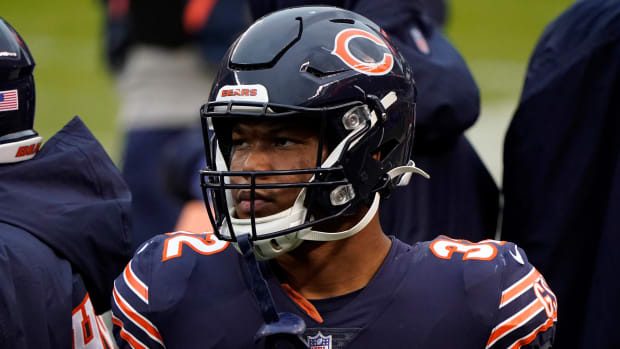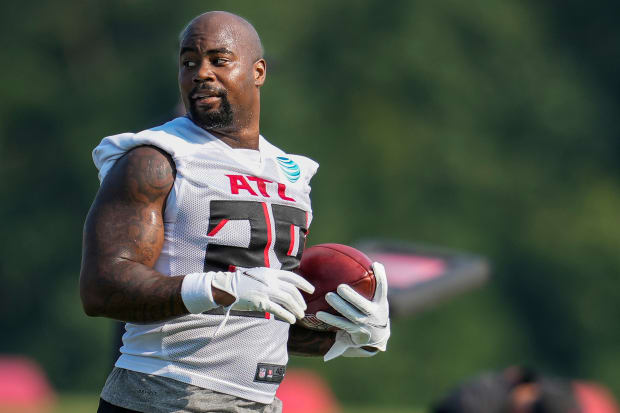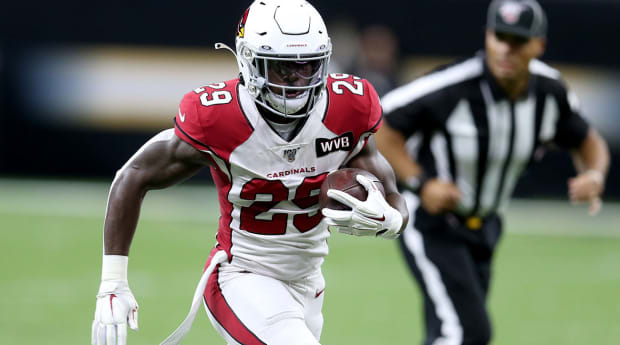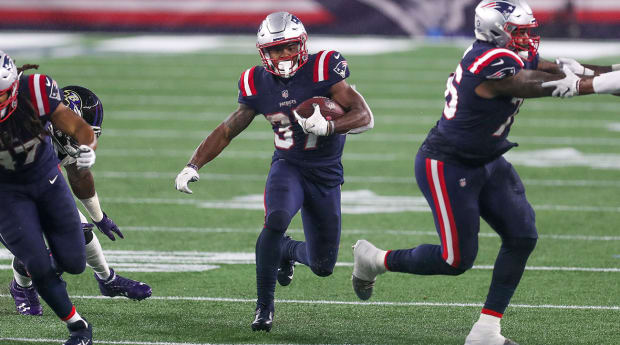David Montgomery headlines a list of fantasy football running back sleepers that can set up your team for success
The run on
first-round running backs puts fantasy players with late first-round picks in a bind. If you take Davante Adams, Travis Kelce, Tyreek Hill, or Stefon Diggs — all great players — late in the first round, the next time your pick comes around, you could be picking from the scraps to fill out your running back spots or worse, find yourself in the RB dead zone.If you don’t get an elite running back in the top half of the first round, consider chasing value and volume by spending a later pick on one of these players. And even if you do use your early picks on top-level talent at the position, these are all viable flex options.
David Montgomery, Chicago Bears

Mike Dinovo/USA TODAY Sports
David Montgomery went on a tear after Chicago's Week 11 bye week last season to finish as the RB4. He was the overall RB1 during that Week 12-17 stretch and recorded three 100-yard games. He was dominating defenses, but Montgomery's average draft position (ADP) doesn't reflect that the last time we saw him on the field,
Jonathan Taylor went on a similar run late in the season, and his ADP soared into the first round. Montgomery’s ADP didn’t rise in the same way Taylor’s did. Getting Montgomery as your RB2 late in the third round is a great value.
Montgomery finished fourth in the NFL in carries (254) and tied for fifth among running backs in receptions (54). That volume should still be there. Pass-catching back Tarik Cohen (ACL) is not yet healthy, which could allow Montgomery to continue to see an expanded role in the passing game. Montgomery doubled his receptions from 2019 to 2020, with Cohen largely sidelined. Chicago’s offense should take off whenever Justin Fields takes over for Andy Dalton. Even if Fields steals a few goal-line carries and takes carries from Montgomery, there should be more first downs and touchdowns to go around in a Fields-led offense.
Mike Davis, Atlanta Falcons

Dale Zanine/USA TODAY Sports
Remember when Mike Davis was 80% of Christian McCaffrey and finished as an RB1? Apparently, not many people do — his current ADP is RB22. Davis is the unquestioned No. 1 back in an offense that projects to be very good and will be led by the offensive coordinator who oversaw Derrick Henry's 2,000-yard season. Davis is no Henry, but he can catch passes. He had the fourth-most receptions among running backs in 2020 (59) on a bottom-10 Panthers offense.
Davis gets a huge upgrade in Atlanta by going from Teddy Bridgewater at quarterback to Matt Ryan. And the Falcons get an upgrade at running back with Davis replacing the ghost of Todd Gurley, who still finished as an RB3 and was a viable fantasy starter from Weeks 1-9, averaging a touchdown per game. There’s no competition behind Davis on the depth chart; the Falcons leading returning rusher is Ryan with 29 yards. It’s Davis’ job to lose.
Chase Edmonds, Arizona Cardinals

As the RB2 on his own team in 2020, Chase Edmonds finished just outside RB2 range and was barely outscored by Miles Sanders and Clyde Edwards-Helaire. Edmonds' touches should increase exponentially this season with Kenyan Drake in Las Vegas, and he's being drafted well after Sanders and Helaire in drafts. That's not to say he should go above them or that there's no competition in Arizona — the Cardinals brought in James Conner, and Kyler Murray can create with his legs — but the potential for a big year from Edmonds is certainly there.
Edmonds was a more efficient rusher and pass catcher than Drake last season. He finished seventh among running backs in receptions (53), and his receiving volume should increase if he's on the field more often, as is expected. But the real boost Edmonds could see is in the run game. Drake ate up 50% of the team's carries, while Edmonds saw just a 20% share. Similarly, the rushing touchdown split favored Drake 10-1. Conner and Edmonds will be sharing rushing volume, but that split should be closer to 50-50 than it was with Drake. Arizona, for its pace, is a good offense to invest in, and Edmonds is a much cheaper investment than Murray or Deandre Hopkins.
Damien Harris, New England Patriots

Paul Rutherford-USA TODAY Sports
Damien Harris asserted himself as the Patriots RB1 in only 10 games a season ago. In the first game of his career with significant volume, he rushed for 100 yards on 17 carries against the Chiefs. That was one of three games Harris reached 100 yards on the ground of the 10 he played and the only one without Cam Newton at quarterback.
The case against Harris is two-fold and obvious: his receiving floor is zero — he had seven targets last season — and Newton stands to poach any potential rushing scores that would come Harris' way. In the nine games Harris and Newton played together, Newton had seven rushing touchdowns to Harris' two. The pitch for Harris, though, is that he projects to be the lead back on a much-improved offense. With actual weapons to throw to (receivers Nelson Agholor and Kendrick Bourne and tight ends Hunter Henry and Jonnu Smith), Newton won't have to take off and run as often as he did in 2020.
Harris is also a highly efficient runner. His 5.0 yards per carry matched that of Dalvin Cook and Alvin Kamara. Even without increased usage, his 69.1 yards per game average would have put him well over 1,000 rushing yards. Given the chance, he’ll clear that mark easily in 2020 and at a low cost for you in the eighth round.
More Fantasy Football:


0 Comments